Long-term test report – 7 October 2008.
So my Mercedes C-class has gone – and I will miss it like few other long-term cars. The C320 CDI really got under my skin. Its presence, its power and its ability to elevate any journey to a special event sucker-punched me a week after its arrival and my captivation grew with every passing mile.
Let’s get the minor niggles out the way first. The C-class saloon is not an ideal family car – at least for parent with toddlers. The cabin isn’t exactly spacious, especially in the back, and although the boot is decently large, it lacks the versatility of a hatch or estate. The paddle shifters feel a bit flimsy. The lightly sprung bootlid could give you a nasty crack on the head if it was caught by a breeze.
Other irritations? Despite a hefty number of optional extras, the centre console still had plenty of blanked-off buttons. But that’s about it. Elsewhere, the latest Mercedes C-class was brilliant.
In Sport trim, the new C-Class strikes a pretty good balance between aggression, athleticism and sleek understatement. Some of its detailing is a bit fussy – like that untidy collection of shutlines just aft of the front wheels – but its overall proportions are, in my opinion, spot on.
And beneath that sheetmetal sits a chassis that’s far friskier and alert than you’d expect. Light but precise steering, firm suspension with a tight reign on unwanted body control and muscular feelsome brakes made the C-class a hoot when pointed down a decent lick of tarmac.
Throw in one of the finest current turbodiesel powerplants and you have an unfeasibly brisk and refined package that can rack up 600 very fast miles between tanks. It’s the torque that makes the C320 CDI such a devastatingly quick point-to-pointer – there’s a mighty 376lb ft of turbo-enhanced torque that arrives at a low 1600rpm. In a nutshell: instant and effortless acceleration in pretty much any of the seven gears.
It’s as a fast cruiser that the C-class truly excels. Accelerating in top gear will see it rocket all too easily into three-figure speeds, but you’d never guess it from the all-but-silent cabin. And despite its insatiable appetite for reeling in much more exotic and powerful machinery, over 9500 miles the Mercedes’ economy rarely dropped below the official 38mpg – an impressive result.
Nothing fell off, broke or failed on the Merc in our six months with the car and we didn’t have to spend a penny other than routine fuel stops. It’s a shame we didn’t spend long enough with the car to test the dealer service, but we’ll aim to do more miles next time round…
I grew up with Mercedes as family cars and I learned to drive in one. I loved their robust and unflappable nature, their smooth performance and unfailing reliability. After the late Nineties/early Noughties off-colour period, which saw my unstinting loyalty to the brand sorely tested, the new C-class has reaffirmed my belief in Mercedes as maker of some of the finest cars in the world.
And in my book, that is a job very well done indeed.
|
Logbook
|
|
Total Mileage
Since Last Report
Overall MPG
Since Last report
Fuel Costs
Other Costs
Highs
Lows
|
9513 miles
1308 miles
38.5 mpg
37.9 mpg
£1418
None
Making those on board feel safe and secure – and the feeling of travelling in something special
Not being able to afford one
|
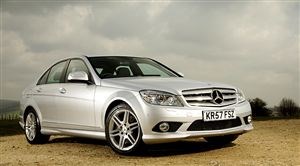
This month, the arrival of an SLK55 AMG test car and the purchase of a second car meant that I didn’t drive my Mercedes for most of last week. And hell, I only realised just how much I appreciated and missed it when I got back into it for a long fast drive into deepest Wales. Normally a 700mile round trip is something to be endured, but I positively relished it in the Mercedes. The C-Class was refined, indecently quick and relaxing. It’s climate control, faultless satnav, digital radio and excellent seats kept me comfortable and entertained, and its 39mpg economy meant stopping just once on the trip to refuel. Driving through some atrocious weather – this is summer, after all – the Mercedes never felt anything but secure and sure-footed in even the heaviest downpours. In short, it reminded me of the Mercedes we had when I was growing up. The Fintail 220 (W111 chassis) and 280SE (W108 chassis) my parents drove were rock solid and utterly reliable, quick and comfortable, qualities enhanced by an understated elegance and low-key luxury. My C-class may lack the older cars’ beautifully balanced proportions and design integrity, but it’s certainly inherited their unflappable competence.
back to top
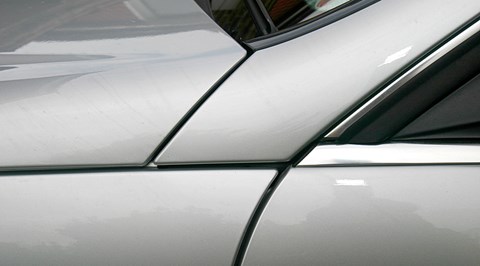 After five months and just over 7000 miles, it’s time to tackle the (admittedly short and somewhat trivial) list of the Mercedes C-class’s irritants and annoyances. Top of the list is the scrappy and untidy meeting of panels below the A-pillar. Where once a glance at a Mercedes would fill me with a warm reminder of possessing something sleek and athletic, now my eyes are drawn to this incongruous collection of panel gaps that seem far wider than those of its rivals. It detracts from the overall proportions of the car and just looks clumsy and heavy-handed.
After five months and just over 7000 miles, it’s time to tackle the (admittedly short and somewhat trivial) list of the Mercedes C-class’s irritants and annoyances. Top of the list is the scrappy and untidy meeting of panels below the A-pillar. Where once a glance at a Mercedes would fill me with a warm reminder of possessing something sleek and athletic, now my eyes are drawn to this incongruous collection of panel gaps that seem far wider than those of its rivals. It detracts from the overall proportions of the car and just looks clumsy and heavy-handed.
The boot uses a clever spring mechanism to pop open when its button on the key fob is thumbed or the internal release is activated. It’s clever because there’s no need for a more expensive and heavier electric automated system. But the problem is a gust of wind can result in the lightly-sprung bootlid giving you a nasty crack on the head as you load your shopping into the hold.
Thirdly, and for some reason I cannot put my finger on exactly why, that row of blank buttons on the centre console really irritates me. This is the top model C-class diesel wearing a hefty £33,775 pricetag – to which £5500 of extras have been added – and it still has three of its four buttons blanked off. This small detail sometimes makes it feel like a basement-spec hire car! It’s a tiny thing that not one other person who has travelled in the car has noticed or mentioned, so maybe I’m just being pernickety. But it still winds me up….
By Ben Whitworth
back to top
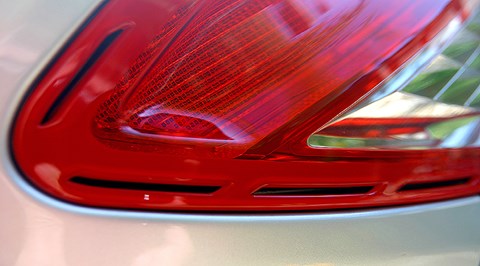 The C320’s headlamps are some of the best I’ve ever used. Its optional Intelligent Light System uses active bi-xenons that are 50 percent more powerful than conventional headlamps. They also automatically adapt to driving conditions, according to a number of speed-related parameters.
The C320’s headlamps are some of the best I’ve ever used. Its optional Intelligent Light System uses active bi-xenons that are 50 percent more powerful than conventional headlamps. They also automatically adapt to driving conditions, according to a number of speed-related parameters.
As you’d expect, they pivot in sync with the steering wheel – by up to 15 degrees – on both dipped and main beam for significantly enhanced cornering vision. Useful on the narrow unlit West Sussex country roads.
Below 25mph the cornering light function is initiated – turn the wheel or activate the indicators and the lights illuminate the side area ahead of the Benz at an angle of up to 65 degrees with a range of around 30 metres. Ideal for dark junctions and poorly lit carparks.
Between 25 and 56mph on dipped beam the light on the driver’s-side throws a wider and brighter cast to illuminate the edge of the road, an ideal setting for country roads. Above 56mph the lights crank up their output to boost vision range by up to 60%. This happens in two stages. Below 68mph the Xenon’s output climbs from 35 to 38 watts – which sounds like an insignificant hike, but the results are amazing. Drive faster and the Xenon beam on the driver’s side is raised, extending the headlamp range to 120 metres. Which means peerless high-speed forward vision.
Which all sounds pretty complicated, but because it all works automatically, you’re only aware that you have a far clearer view of the road ahead where you are looking, rather than where the nose of the car is pointing. The lights are without doubt a key safety element.
And the rear lamps are pretty trick, too. As well as flashing during heavy braking to warn drivers behind, they also play a key aerodynamic role. Those vents that border the lights do the job of a rear spoiler. Air sucked in from beneath the car is conducted up and through the air vents in the lights, tidying up the flow of air along the car’s flanks. This abrupt redirection of airflow virtually eliminates tail-end turbulence which would otherwise adversely affect rear axle lift and yaw characteristics. Result? No need for a spoiler on the bootlid.
By Ben Whitworth
back to top

Lower consumption and emission figures may make for good headlines, but to really evaluate a vehicle’s environmental impact you need a far more holistic approach. One that starts when lumps of iron ore are taken out of the ground and finishes at the end of recycling. Boasting that your car returns 50mpg and less than 125g of CO2 per kilometre when it’s produced in a factory that has an appalling environmental record is false economy at best, hypocrisy at worst.
I’m not saying that my C-class casts the smallest and cleanest carbon footprint – although 39mpg and CO2 193g/km for a 155mph family car is pretty impressive – but take a look at its whole life impact and it’s astoundingly good. Along with the A, B and S-classes, the new C-class is the only car on the market to be awarded an Environmental Certificate by the TÜV – German’s independent and hugely powerful Technical Monitoring Association. It confirmed both the C-class estate and saloon’s development was environmentally focused, determining that the car’s development process meets the requirements of the internationally recognised ISO standard 14062. Which means the way it’s developed, engineered, produced, distributed, repaired and recycled as greenly as possible.
The TÜV’s certification is the automotive equivalent of a product like coffee or chocolate achieving Fairtrade standards – you know when you buy it that everything and everyone along the entire production process has been treated justly – and in the case of the C-class, that means the environment.
By Ben Whitworth
back to top
 Interesting how brow-furrowing technology at the leading edge quickly becomes assimilated. The Linguatronic system in the Benz is the perfect example. Why do I need to tell my car what to do? Dials, buttons and switches have worked perfectly adequately for more than a century, so why do I need some seemingly over-complex voice activated system instead?
Interesting how brow-furrowing technology at the leading edge quickly becomes assimilated. The Linguatronic system in the Benz is the perfect example. Why do I need to tell my car what to do? Dials, buttons and switches have worked perfectly adequately for more than a century, so why do I need some seemingly over-complex voice activated system instead?
Because, after two days’ use, I’ve realised that it’s bloody brilliant. I simply thumb the talk button on the steering wheel, say where I want to go, what station I want to listen to, or what song I want played – and with eerie efficiency, my wish is the Linguatronic’s command. Setting up the system takes a few minutes; a polite lady tells me to run through the alphabet, count to ten and repeat a few basic words. And that’s it. Whether you have a cold, the windows down or a mouthful of chocolate, the system’s incredibly sophisticated voice pattern system works out what you’ve just said.
It’s also unquestionably safer – not having to constantly fiddle with buttons while flicking your eyes between road and screen makes real sense when every other driver out there seems hell bent on taking me out.
By Ben Whitworth
Back to top
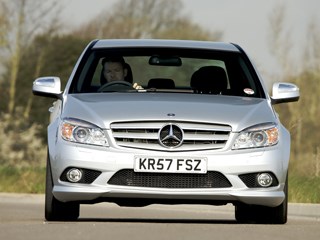 I am so very fickle. I was heartbroken by the recent departure of my much-loved Volvo long-termer. Nothing, I vowed, could replace it. And yet here I am, just a few weeks on, developing an almost fanatical obsession with my Mercedes-Benz C320 CDI, a car that couldn’t be more different from the XC70. Family-friendly versatility, chunky estate styling and go-anywhere ability? Sod that. I’m besotted with the Benz’s rabid pace, rear-drive dynamics and muscular iamthedaddy styling.
I am so very fickle. I was heartbroken by the recent departure of my much-loved Volvo long-termer. Nothing, I vowed, could replace it. And yet here I am, just a few weeks on, developing an almost fanatical obsession with my Mercedes-Benz C320 CDI, a car that couldn’t be more different from the XC70. Family-friendly versatility, chunky estate styling and go-anywhere ability? Sod that. I’m besotted with the Benz’s rabid pace, rear-drive dynamics and muscular iamthedaddy styling.
I learned to drive in a Mercedes, an excited toddler perched on my father’s lap so I could peer over the big Benz’s big white steering wheel as we trundled down our drive. And despite some tricky times (the A-Class debacle, appalling late ‘90s reliability, the doomed Chrysler affair) I’ve always remained a stalwart – if closet –Mercedes fan.
And the C320 CDI effortlessly exceeds my expectations. I’m suckered by its looks. It’s gone from the BMW 3-series’ geeky schoolyard punch bag to a lean and muscular rival with spot-on proportions and, in Sport guise, enough visual aggression to clear the fast lane and make its German and Japanese rivals look a little flabby and dull.
Its 3.0litre blown diesel (don’t be fooled by the 320 badge) is a refined and muscular gem. It’s not the 224bhp that’s important here (although it’s enough for a limited 155mph top speed) but the mountainous 376lb ft of torque that arrives in a massive wave at just 1600rpm. It rockets the Benz along, delivering the kind of effortless low-rev high-speed punch that’s both aggressive to those being overtaken and laidback for the driver. Even better when average fuel economy hovers around 38mpg.
So, it looks the business and goes like the clappers. But it also has one feature not found on the spec sheet – it makes me feel special when I drive it. The Benz feels distinctive and polished, something exclusive when everything else looks and feels slightly common, an impression underpinned by its understated, intelligently configured cabin.
So what’s not to like? Okay, so rear accommodation for my two children is nowhere near as spacious as it was in the Volvo. And although the boot is large, is smaller than we’re accustomed to – we’ll just have to carry less baby and toddler-oriented nonsense when we travel. Prices worth paying for the Benz’s superb pace, style and dynamics? You’re damn right.
By Ben Whitworth
Back to top
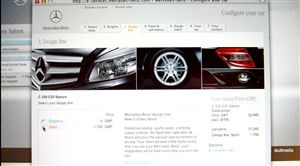 Configuring my new C320 CDI on the Mercedes-Benz website was a lesson in restraint. And one I flunked. With its simple tickbox system that immediately pictorialised my choices on screen, it was all too easy to get carried away. Upgrading from sedate Elegance to aggressive Sport (body kit, 17-inch AMG alloys, paddleshifters, grippier seats, uprated suspension and outta-my-way grille, among others) was a no brainer, given the saloon’s gutsy diesel performance. So that’s £1700 added to the basic £33,775 OTR price.
Configuring my new C320 CDI on the Mercedes-Benz website was a lesson in restraint. And one I flunked. With its simple tickbox system that immediately pictorialised my choices on screen, it was all too easy to get carried away. Upgrading from sedate Elegance to aggressive Sport (body kit, 17-inch AMG alloys, paddleshifters, grippier seats, uprated suspension and outta-my-way grille, among others) was a no brainer, given the saloon’s gutsy diesel performance. So that’s £1700 added to the basic £33,775 OTR price.
And what good is a sleek executive rocket without metallic paint (Palladium Silver at £620) or leather (black, £1295) or a set of piercing active bi-xenon headlights (£975). Boy that total figure has certainly jumped… but hang on, what about Parktronic (£605) and Comand with hard disc sat-nav, voice control and an ear-bleeding sound system that will accept and memorise any and all format of music (£1995)? Click, click, click.
Look at the total, swallow hard and move onto another tantalising list of options, like heated front seats (£320) three-zone digital climate zone (£470) and digital radio (£320). A few more clicks, a few more screens and I get to the end of the configuration faced with a £40,975 bill. Hell, the editor is going to blow a valve…
By Ben Whitworth
Back to top